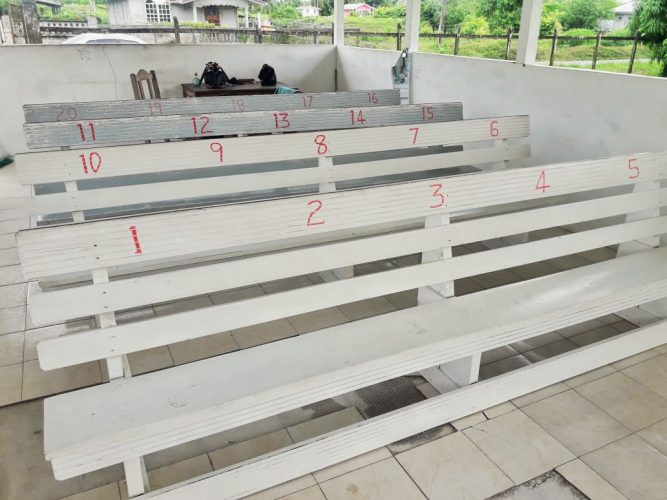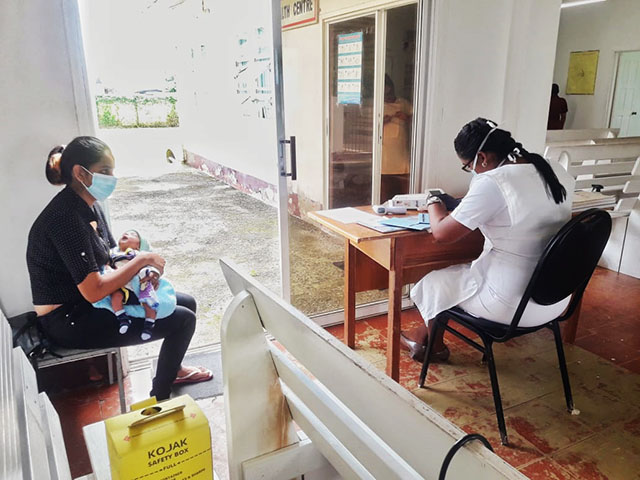The Canal Number Two health centres will be hosting a screening programme for the general public tomorrow and the medical personnel there say that despite the effects of the coronavirus pandemic, they intend to contribute to the prevention of the spread of the virus and will continue to serve the public.
Earlier this week, when Stabroek News met with officials from the two health centres, they pointed out the extra measures put in place to protect themselves and patients. The health centres cater to approximately six thousand residents of the dozen villages situated along Canal Number Two. Belle West Health Centre alone services 2,600 persons residing in both phases of the housing scheme. However, they do see patients coming from the other communities in Canal Number Two.
Fading neon green paint showed the marked off spots in the compound outside of the Belle West Health Centre where patients would stand on a busy day in compliance with the physical distancing measures, but on Wednesday morning, just past the 9 o’clock hour, only one young mother with her weeks’ old baby was there for the nurses to tend to. This was the child’s first visit to the health centre so he was being registered. The mother had showed up to the health facility without a mask but was provided one while she was there.

Wednesdays are designated for infants and usually the medical personnel here would see about 6 to 10 of these patients each Wednesday. To avoid overcrowding, parents are given different Wednesdays in the month to bring their child/children to clinic.
Senior Medex, Jaikaran Narine, who was present when this newspaper visited, explained that he is in charge of both health centres and Wednesday was one of the three days he would visit Belle West. As the senior medex, his office is at the West Demerara Regional Hospital (WDRH) and he is responsible for supervising the community health workers and the medexes. He explained that there was a doctor stationed in Number Two Canal who would rotate between the health centres, but owing to the pandemic, the doctor is needed at the WDRH so he rotates between the health centres and the hospital. Currently along with Narine, the facility is also staffed with a midwife, a nurse and two community health workers, as well as a janitor.
Narine informed that patients visiting the health centres are sanitised and screened according to a checklist to determine whether the patient has any COVID-19 symptoms. Patients are assessed for fever, shortness of breath, cough, and the other associated symptoms. Patients who display a number of the symptoms are taken to the WDRH. There is a hotline in Region Three operated by the hospital. According to the Medex, the hotline number would be called and a vehicle summoned for the patient to be transported to the hospital where they would undergo testing.
The medex noted that there have been several instances where a patient was suspected to have the virus and the hotline was called, but none of the patients he said, have tested positive. They were then given the necessary treatment and sent home.
“Monday, we deal with chronic diseases which are like the diabetic patients, hypertensive patients and all other chronic illnesses. On Tuesday we would have antenatal clinic which are for pregnant mothers. Thursdays are family planning and Fridays are admission of newborns. But, we also have general clinic every day as we receive general cases so if a patient is sick and they come, we see them”, Narine said.
Waiting areas
The health centre, he said, operates from 8am to 4:30pm Mondays to Fridays. However, the majority of the patients come from eight to ten in the mornings. At the Belle West Health Centre there are two waiting areas, one inside the building and the other under a shed outside of the building. Currently, because of COVID-19, patients are asked to wait under the shed and enter the building one at a time to be seen by a medical official. With Monday set aside for chronic diseases, it is deemed the day with the most patients. According to the medex, if there is an average of fifty patients to be seen for chronic illnesses over a monthly period, then they are divided into four groups so that less persons are present so as to enable proper physical distancing.
Patients suffering from diabetes and hypertension are said to be at the top of the list when it comes to chronic cases. Lower down the list are those with high cholesterol, arthritis, and gastritis. These patients are required to come to clinic on a regular basis as they need their medications. With the doctor unable to be present, the medex is needed for chronic clinic, which he explains is not just about repeating a patient’s treatment but also checking for further complications which may require more or less dosage of the medication or even a different treatment altogether.
Narine assured that the necessary precautions have been taken to ensure that the benches in the waiting area are numbered and each number several feet apart to allow for physical distancing.
“These mothers who come today [Wednesday], are coming specifically for vaccines but if we have a baby that has to come to the regular clinic just for weighing and to check the growth development and so forth, we would not bring them unnecessarily in the crowd due to the COVID, so their regular checkups now will have like a two-months space and we bring them but if they have to get vaccines we bring those babies to get vaccines because we want all our babies to be immunized,” the medex said.
Asked whether the health facility has seen less patients owing to persons not wanting to visit for fear of contracting the virus, Narine said no, adding that persons who are sick are coming anyway.
He shared that many of the persons visiting the health centres are curious about the pandemic and he and his medical team would find themselves daily answering questions on that topic.
Narine said also, that there has been an increase in patients suffering from anxiety/depression over the past several months. He believes that the spike in patients suffering from this could be linked to being worried about the pandemic, having lost their jobs, and possibly the drawn-out election. “Just yesterday [Tuesday] I had three cases with anxiety and depression.”
The medex also assured that the facility has enough medical supplies and patients can access their medications without any problem.
Shedding some light on the COVID-19 screening process to come tomorrow, the medex said that all persons are welcomed to be screened for the virus at either of the health centres if they so desire.
Meanwhile, over at Canal Number Two Health Centre, it was just as empty except for one pregnant young woman and her mother. All visitors were expected to wash their hands at the sink installed on the outside of the building. Following this procedure, this reporter then had her temperature checked and went through the screening process before meeting with the midwife.
Midwife, Bhanmatie Lawnand who has been employed at the health centre for some eight years works from Monday to Friday excluding Tuesday. On that day she works in Belle West at the antenatal clinic.
Unlike Belle West Health Centre, she noted that since the beginning of the COVID-19’s arrival in Guyana, there has been a decline in patients visiting the health facility. For antenatal clinics, pregnant mothers in their first trimester and at the beginning of the second trimester, instead of visiting the health centre regularly every month, are now attending clinic every six to seven weeks owing to the pandemic. However, for mothers who are at thirty two weeks and above, the regular weekly clinics must be maintained for them.
She listed the various days for the different clinics: Mondays – Family Planning Clinic, Tuesdays – Infant Clinic, Wednesdays – Antenatal Clinic, Thursdays – Chronic Disease Clinic and Outpatients, and Fridays – admission of newborns. Tuesdays from 1pm are for patients who need to have their wounds dressed. The chronic disease clinic at this facility is said to be much larger than that of Belle West. Every Thursday they see an average of forty to fifty patients and because the patient load is so big, patients are given different times throughout the day to come to clinic. Medex Narine is present for this clinic.
“For the antenatal clinic, pregnant mothers are asked to be here before 10am because we want to give a health talk at one time to all the mothers instead of them coming after that and we have to redo the health talk individually. I still give health talk individually…. Persons come wearing their masks and if they don’t, we provide one for them,” Lawnand said.
She noted while persons have turned up with the common cold and flu, she has not yet seen any patients arrive with the symptoms of the cold or flu along with shortness of breath and diarrhoea that would cause them to have to call the COVID hotline.
Among the questions asked of this reporter during the screening process, was whether she had visited other areas outside of Canal Number Two. In light of this question, Lawnand was asked how worried they are about persons travelling out of the community. She responded, “We are very concerned about this. We have a lot of persons travelling out of the area, mostly to go to the Vreed-en-Hoop and Georgetown markets.”
She too assured that the health facility has the adequate medical supplies but only for the time being.
Stacy Vanlong who is seven months along in her pregnancy had arrived some minutes later and was seated waiting to be called. Vanlong, a mother of three, ages 2, 4 and 7, said that she takes care not to be away from home.
Her husband, a farmer and vendor, operates his vending business at the Stabroek Market on weekends. She said she is especially worried about him having to travel to the city for his business because of the number of cases in that area adding that they both try to be health conscious to avoid contracting the virus and passing it on to their children. However, she noted that because a relative of the family is the one who provides transportation for her husband and his farm produce, he doesn’t have to worry about the danger of taking public transportation.





